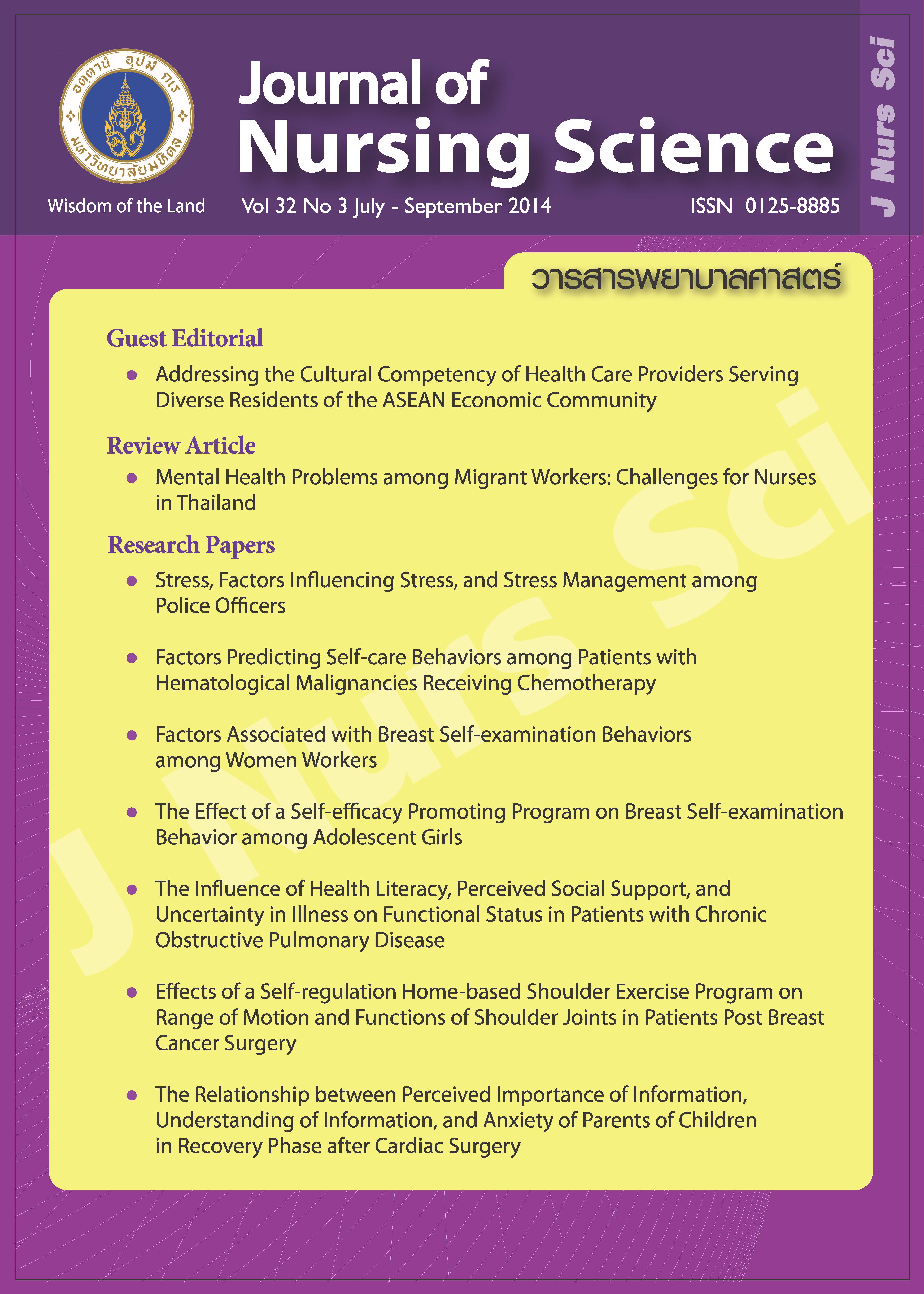Effects of a Self-regulation Home-based Shoulder Exercise Program on Range of Motion and Functions of Shoulder Joints in Patients Post Breast Cancer Surgery
Main Article Content
Abstract
Purpose: To determine the effects of a self-regulation home-based shoulder exercise program on range of motion and functions of shoulder joints in patients post breast cancer surgery.
Design: Experimental research.
Methods: After surgery for breast cancer surgery 57 patients from Siriraj Hospital were randomly assigned to a control group (n = 28) receiving conventional care and an experimental group (n = 29) receiving a self-regulation home-based shoulder exercise program and conventional care. Data were collected 2 phases at pre-operation and 6 weeks after surgery using a demographic questionnaire, goniometer and record form, an assessment form for arm-shoulder functions. Data analysis was performed using descriptive statistics and Mann-Whiney U test.
Main findings: The results indicated that at 6 weeks after surgery for breast cancer patients in the experimental group had better range of motion of shoulder, particularly the flexion position, than those in the control group at significance level .05. However, shoulder functions in both groups was not significantly different at significance level .05. From a daily record of shoulder exercise, most subjects in the experimental group practiced exercise positions that were easy and caused less pain.
Conclusion and recommendations: The study findings suggest that the home-based shoulder exercise program needs certain improvements of exercise positions that cause less pain and high range of motion, pain reduction technique, and information strengthening self-efficacy which, in turn, will increase effective self-regulation in shoulder exercise.
Keywords: breast cancer surgery, range of motion of shoulder joints, self-regulation, shoulder functions, shoulder exercise program
ผลของโปรแกรมการกำกับตนเองในการบริหารข้อไหล่ที่บ้านต่อองศาการเคลื่อนไหวและการทำหน้าที่ของข้อไหล่ในผู้ป่วยหลังผ่าตัดมะเร็งเต้านม
บทคัดย่อ
วัตถุประสงค์: เพื่อศึกษาผลของโปรแกรมการกำกับตนเองในการบริหารข้อไหล่ที่บ้านต่อองศาการเคลื่อนไหวและทำหน้าที่ของข้อไหล่ในผู้ป่วยหลังผ่าตัดมะเร็งเต้านม
รูปแบบการวิจัย: การวิจัยครั้งนี้เป็นการวิจัยทดลอง
วิธีดำเนินการวิจัย: กลุ่มตัวอย่าง 57 คน เป็นผู้ป่วยหลังผ่าตัดมะเร็งเต้านมที่รับการรักษาในโรงพยาบาลศิริราช สุ่มเข้ากลุ่มควบคุม 28 คน ซึ่งได้รับการพยาบาลตามปกติ และกลุ่มทดลอง 29 คน ซึ่งได้รับโปรแกรมการกำกับตนเองฯ ร่วมกับการพยาบาลตามปกติ เก็บรวบรวมข้อมูลในระยะก่อนผ่าตัด และ 6 สัปดาห์หลังผ่าตัด โดยใช้แบบสอบถามข้อมูลส่วนบุคคล โกนิโอมิเตอร์และแบบบันทึกผลแบบประเมินการทำหน้าที่ของแขนและข้อไหล่ วิเคราะห์ข้อมูลโดยใช้สถิติพรรณนาและการทดสอบแมนวิทนีย์ ยู
ผลการวิจัย : พบว่าผู้ป่วยหลังผ่าตัดมะเร็งเต้านมในกลุ่มทดลอง มีองศาการเคลื่อนไหวของข้อไหล่ในท่างอแขนดีกว่าผู้ป่วยในกลุ่มควบคุม ที่นัยสำคัญทางสถิติ .05 ส่วนคะแนนการทำหน้าที่ของข้อไหล่ของผู้ป่วยหลังผ่าตัดมะเร็งเต้านมของทั้งสองกลุ่มไม่แตกต่างกันที่นัยสำคัญทางสถิติ .05 และจากแบบบันทึกการบริหารข้อไหล่ พบว่า กลุ่มทดลองเลือกท่าบริหารที่ง่ายและเจ็บปวดน้อยที่สุด
สรุปข้อเสนอแนะ: ผลการศึกษาให้ข้อเสนอแนะในการปรับปรุงโปรแกรมการบริหารข้อไหล่ที่บ้าน โดยปรับท่าบริหารที่ทำให้เจ็บปวดน้อยแต่มีผลต่อองศาการเคลื่อนไหวของข้อไหล่ เพิ่มการสอนวิธีลดความเจ็บปวด และให้ข้อมูลที่มุ่งเน้นให้เกิดการรับรู้สมรรถนะของตนเองมากขึ้นในการบริหารข้อไหล่ เพื่อให้เกิดการกำกับตนเองอย่างมีประสิทธิผล
คำสำคัญ: ผ่าตัดมะเร็งเต้านม องศาการเคลื่อนไหวของข้อไหล่ การกำกับตนเอง การทำหน้าที่ของข้อไหล่ โปรแกรมการบริหารข้อไหล่
Article Details
Copyright Notice: Nursing Science Journal of Thailand has exclusive rights to publish and distribute the manuscript and all contents therein. Without the journal’s permission, the dissemination of the manuscript in another journal or online, and the reproduction of the manuscript for non-educational purpose are prohibited.

Disclaimer: The opinion expressed and figures provided in this journal, NSJT, are the sole responsibility of the authors. The editorial board bears no responsibility in this regard.


